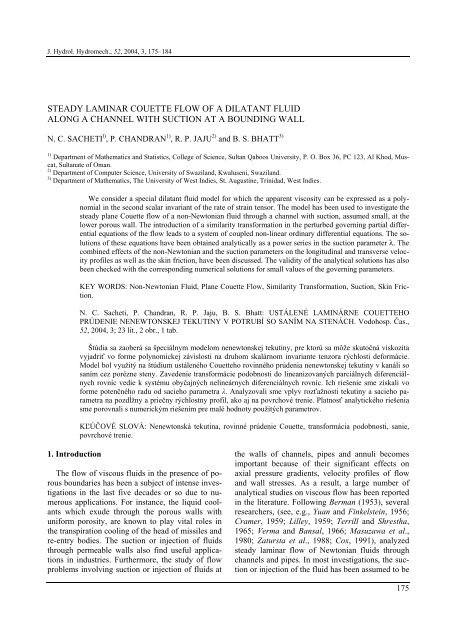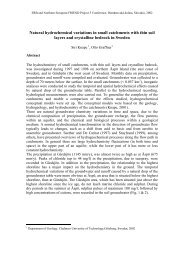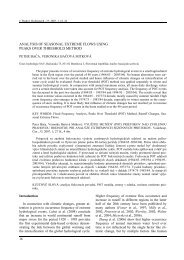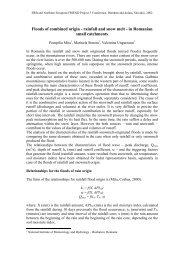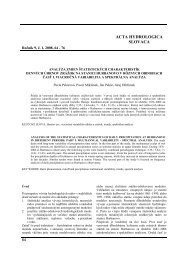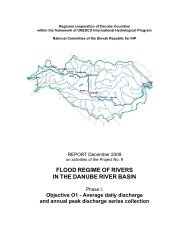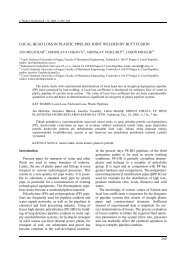steady laminar couette flow of a dilatant fluid along a channel with ...
steady laminar couette flow of a dilatant fluid along a channel with ...
steady laminar couette flow of a dilatant fluid along a channel with ...
You also want an ePaper? Increase the reach of your titles
YUMPU automatically turns print PDFs into web optimized ePapers that Google loves.
J. Hydrol. Hydromech., 52, 2004, 3, 175–184<br />
STEADY LAMINAR COUETTE FLOW OF A DILATANT FLUID<br />
ALONG A CHANNEL WITH SUCTION AT A BOUNDING WALL<br />
N. C. SACHETI l) , P. CHANDRAN 1) , R. P. JAJU 2) and B. S. BHATT 3)<br />
1)<br />
Department <strong>of</strong> Mathematics and Statistics, College <strong>of</strong> Science, Sultan Qaboos University, P. O. Box 36, PC 123, Al Khod, Muscat,<br />
Sultanate <strong>of</strong> Oman.<br />
2)<br />
Department <strong>of</strong> Computer Science, University <strong>of</strong> Swaziland, Kwaluseni, Swaziland.<br />
3)<br />
Department <strong>of</strong> Mathematics, The University <strong>of</strong> West Indies, St. Augustine, Trinidad, West Indies.<br />
1. Introduction<br />
We consider a special <strong>dilatant</strong> <strong>fluid</strong> model for which the apparent viscosity can be expressed as a polynomial<br />
in the second scalar invariant <strong>of</strong> the rate <strong>of</strong> strain tensor. The model has been used to investigate the<br />
<strong>steady</strong> plane Couette <strong>flow</strong> <strong>of</strong> a non-Newtonian <strong>fluid</strong> through a <strong>channel</strong> <strong>with</strong> suction, assumed small, at the<br />
lower porous wall. The introduction <strong>of</strong> a similarity transformation in the perturbed governing partial differential<br />
equations <strong>of</strong> the <strong>flow</strong> leads to a system <strong>of</strong> coupled non-linear ordinary differential equations. The solutions<br />
<strong>of</strong> these equations have been obtained analytically as a power series in the suction parameter λ. The<br />
combined effects <strong>of</strong> the non-Newtonian and the suction parameters on the longitudinal and transverse velocity<br />
pr<strong>of</strong>iles as well as the skin friction, have been discussed. The validity <strong>of</strong> the analytical solutions has also<br />
been checked <strong>with</strong> the corresponding numerical solutions for small values <strong>of</strong> the governing parameters.<br />
KEY WORDS: Non-Newtonian Fluid, Plane Couette Flow, Similarity Transformation, Suction, Skin Friction.<br />
N. C. Sacheti, P. Chandran, R. P. Jaju, B. S. Bhatt: USTÁLENÉ LAMINÁRNE COUETTEHO<br />
PRÚDENIE NENEWTONSKEJ TEKUTINY V POTRUBÍ SO SANÍM NA STENÁCH. Vodohosp. Čas.,<br />
52, 2004, 3; 23 lit., 2 obr., 1 tab.<br />
Štúdia sa zaoberá sa špeciálnym modelom nenewtonskej tekutiny, pre ktorú sa môže skutočná viskozita<br />
vyjadriť vo forme polynomickej závislosti na druhom skalárnom invariante tenzora rýchlosti deformácie.<br />
Model bol využitý na štúdium ustáleného Couetteho rovinného prúdenia nenewtonskej tekutiny v kanáli so<br />
saním cez porézne steny. Zavedenie transformácie podobnosti do lineanizovaných parciálnych diferenciálnych<br />
rovníc vedie k systému obyčajných nelineárnych diferenciálnych rovníc. Ich riešenie sme získali vo<br />
forme potenčného radu od sacieho parametra λ. Analyzovali sme vplyv rozťažnosti tekutiny a sacieho parametra<br />
na pozdĺžny a priečny rýchlostny pr<strong>of</strong>il, ako aj na povrchové trenie. Platnosť analytického riešenia<br />
sme porovnali s numerickým riešením pre malé hodnoty použitých parametrov.<br />
KĽÚČOVÉ SLOVÁ: Nenewtonská tekutina, rovinné prúdenie Couette, transformácia podobnosti, sanie,<br />
povrchové trenie.<br />
The <strong>flow</strong> <strong>of</strong> viscous <strong>fluid</strong>s in the presence <strong>of</strong> porous<br />
boundaries has been a subject <strong>of</strong> intense investigations<br />
in the last five decades or so due to numerous<br />
applications. For instance, the liquid coolants<br />
which exude through the porous walls <strong>with</strong><br />
uniform porosity, are known to play vital roles in<br />
the transpiration cooling <strong>of</strong> the head <strong>of</strong> missiles and<br />
re-entry bodies. The suction or injection <strong>of</strong> <strong>fluid</strong>s<br />
through permeable walls also find useful applications<br />
in industries. Furthermore, the study <strong>of</strong> <strong>flow</strong><br />
problems involving suction or injection <strong>of</strong> <strong>fluid</strong>s at<br />
the walls <strong>of</strong> <strong>channel</strong>s, pipes and annuli becomes<br />
important because <strong>of</strong> their significant effects on<br />
axial pressure gradients, velocity pr<strong>of</strong>iles <strong>of</strong> <strong>flow</strong><br />
and wall stresses. As a result, a large number <strong>of</strong><br />
analytical studies on viscous <strong>flow</strong> has been reported<br />
in the literature. Following Berman (1953), several<br />
researchers, (see, e.g., Yuan and Finkelstein, 1956;<br />
Cramer, 1959; Lilley, 1959; Terrill and Shrestha,<br />
1965; Verma and Bansal, 1966; Masuzawa et al.,<br />
1980; Zatursta et al., 1988; Cox, 1991), analyzed<br />
<strong>steady</strong> <strong>laminar</strong> <strong>flow</strong> <strong>of</strong> Newtonian <strong>fluid</strong>s through<br />
<strong>channel</strong>s and pipes. In most investigations, the suction<br />
or injection <strong>of</strong> the <strong>fluid</strong> has been assumed to be<br />
175
N. C. Sacheti, P. Chandran, R. P. Jaju, B. S. Bhatt<br />
normal to the porous walls <strong>of</strong> same or different<br />
permeabilities, although some researchers have also<br />
considered oblique suction (Weidman and Amberg,<br />
1996). The analytical solutions in these studies<br />
have generally been obtained under the assumption<br />
that the suction or injection Reynolds number is<br />
small.<br />
On the other hand, several investigators have extended<br />
the viscous <strong>flow</strong> problems mentioned above<br />
to non-Newtonian <strong>fluid</strong>s, apparently because <strong>of</strong><br />
increasing technological applications <strong>of</strong> rheological<br />
<strong>fluid</strong>s. In doing so, a number <strong>of</strong> non-Newtonian<br />
<strong>fluid</strong> models has been proposed in the literature<br />
(Narasimhan, 1961; Rajvanshi, 1968; Bhatnagar,<br />
1971; Sacheti, 1976; Sacheti and Bhatt, 1976; Ariel,<br />
1992). However, the analysis <strong>of</strong> the <strong>flow</strong> <strong>of</strong> non-<br />
Newtonian <strong>fluid</strong>s through porous <strong>channel</strong>s or pipes<br />
presents mathematical difficulties because <strong>of</strong> the<br />
non-linearity <strong>of</strong> the governing equations. Recently,<br />
Ariel (2002) has discussed <strong>steady</strong> <strong>laminar</strong> <strong>flow</strong> <strong>of</strong> a<br />
second grade <strong>fluid</strong> through two parallel porous<br />
walls, and obtained exact analytical solutions as<br />
well as perturbation solutions, assuming that the<br />
rate <strong>of</strong> injection at one wall is equal to the rate <strong>of</strong><br />
suction at the other wall. The present investigation<br />
considers the extension <strong>of</strong> a classical Couette <strong>flow</strong><br />
problem <strong>with</strong> small suction at the lower wall, to a<br />
special <strong>dilatant</strong> <strong>fluid</strong> model which has received<br />
relatively less attention in the literature. Our main<br />
objective is thus to discuss the effect <strong>of</strong> wall porosity<br />
on the ensuing non-Newtonian <strong>flow</strong>.<br />
2. The <strong>fluid</strong> model and the governing equations<br />
As is known, a constitutive equation <strong>of</strong> an inelastic<br />
non-Newtonian <strong>fluid</strong> can be represented as (Bird<br />
et al., 1960)<br />
τ µ<br />
ij = ( I1, I2, I3) eij<br />
, (1)<br />
where I 1,<br />
I 2 and I 3 are the scalar invariants <strong>of</strong> the<br />
rate <strong>of</strong> strain tensor. For two-dimensional <strong>flow</strong>, as<br />
is being considered in the present study, I 1 and I 3<br />
vanish identically so that µ becomes a function <strong>of</strong><br />
I 2 only. We furthermore assume that µ can be<br />
approximated as a power series in I 2 , and write<br />
176<br />
2<br />
2 0 1 2 2 2<br />
µ ( I ) = µ + µ I + µ I + ...,<br />
(2)<br />
where µ 0 is the conventional Newtonian viscosity,<br />
while the parameters µ 1 , µ 2 , ⋯ , indicate the non-<br />
Newtonian character <strong>of</strong> the <strong>fluid</strong>. In the present<br />
study, we consider the <strong>fluid</strong> model <strong>with</strong> the constitutive<br />
equation<br />
τ µ µ<br />
ij = ( 0 + 1I2) eij.<br />
(3)<br />
Eqs. (2) and (3) allow us to account for the shearthickening<br />
behaviour <strong>of</strong> the inelastic <strong>fluid</strong>. The<br />
model described by Eq. (3) and a model <strong>with</strong> the<br />
higher order effect had recently been employed to<br />
study the stagnation point <strong>flow</strong> near a stationary<br />
impermeable wall (Sacheti et al., 2000, 2003). In<br />
the present work, the model given by Eq. (3) is<br />
used to analyze the plane Couette <strong>flow</strong> subject to<br />
suction at the lower boundary.<br />
We thus consider the <strong>steady</strong>, <strong>laminar</strong> <strong>flow</strong> <strong>of</strong> the<br />
inelastic <strong>fluid</strong> in a <strong>channel</strong> bounded by two infinite<br />
parallel plates distant h apart. In the Cartesian coordinate<br />
system, <strong>with</strong> a suitably chosen origin, the<br />
x -axis is taken <strong>along</strong> the stationary lower porous<br />
plate, while the y-axis is taken perpendicular to it<br />
into the <strong>fluid</strong>. Let u( xy , ) and v( xy , ) denote the<br />
<strong>fluid</strong> velocities in the x and y directions, respectively.<br />
The upper plate, y= h,<br />
is assumed to be<br />
moving <strong>with</strong> a uniform velocity U in the xdirection.<br />
In addition, the <strong>fluid</strong> <strong>flow</strong> is subject to a<br />
uniform suction given by v =− v0<br />
at the stationary<br />
plate y = 0. Under the assumption <strong>of</strong> constant density<br />
ρ <strong>of</strong> the <strong>fluid</strong>, the equations governing the<br />
velocity components u( xy, , ) v( xy , ) and the pressure<br />
pxy ( , ) are the usual equations <strong>of</strong> continuity<br />
and momentum, and are given by<br />
∂u ∂v<br />
+ = 0,<br />
∂x ∂y<br />
⎛ ∂u ∂u⎞ ∂p<br />
∂τ<br />
∂τ<br />
ρ u v<br />
xx<br />
⎜ + ⎟ = − + +<br />
⎝ ∂x ∂y⎠ ∂x ∂x ∂y<br />
⎛ ∂v ∂v⎞ ∂p<br />
∂τ∂τ ρ ⎜u + v ⎟ = − + +<br />
⎝ ∂x ∂y⎠ ∂y ∂x ∂y<br />
xy<br />
xy yy<br />
,<br />
.<br />
(4)<br />
(5)<br />
(6)<br />
On using the rheological model (3), Eqs. (5) and (6)<br />
can be shown to transform to
2 2<br />
⎛ ∂u∂u⎞ ∂p ⎛∂ u ∂ u⎞<br />
ρ ⎜u + v ⎟ = − + µ 0 ⎜ + ⎟<br />
x y x 2 2<br />
⎝ ∂ ∂ ⎠ ∂ ⎜∂x ∂y<br />
⎟<br />
⎝ ⎠<br />
2 2<br />
⎛∂u⎞ ∂ u<br />
+ 16µ<br />
1 ⎜ ⎟<br />
⎝∂x⎠ 2<br />
∂x<br />
⎧ 2 2 2 2<br />
⎪ u u v<br />
⎫⎛ ⎛∂ ⎞ ⎛∂ ∂ ⎞ ⎪ ∂ u ∂ u⎞<br />
1 ⎨4⎜ ⎟ ⎬⎜<br />
⎟<br />
2 2<br />
+ µ ⎜ ⎟ + + +<br />
⎝∂x⎠ ⎝∂y ∂x⎠<br />
⎜∂x ∂y<br />
⎟<br />
⎩⎪ ⎭⎪⎝<br />
⎠<br />
2 2 2<br />
⎛∂u ∂v⎞ ⎛∂ u ∂ u⎞<br />
+ 2µ<br />
1 ⎜ + ⎟ ⎜ − ⎟<br />
y x 2 2<br />
⎝∂ ∂ ⎠<br />
⎜∂y ∂x<br />
⎟<br />
⎝ ⎠<br />
2 2<br />
2 ,<br />
⎛ u ∂ v⎞<br />
⎜ + ⎟<br />
∂u⎛∂u ∂v⎞ ∂<br />
+ 4µ 1 ⎜ + ⎟ 3<br />
∂x⎝∂y ∂x⎠<br />
⎜ ∂∂ xy ∂x<br />
⎟<br />
⎝ ⎠<br />
2 2<br />
⎛ ∂v∂v⎞ ∂p ⎛∂ v ∂ v⎞<br />
ρ ⎜u + v ⎟ = − + µ 0 ⎜ + ⎟<br />
x y y 2 2<br />
⎝ ∂ ∂ ⎠ ∂ ⎜∂x ∂y<br />
⎟<br />
⎝ ⎠<br />
2 2<br />
⎛∂ ⎞ ∂<br />
− 16µ<br />
1 ⎜ ⎟<br />
u u<br />
⎝∂x⎠ ∂y∂x ⎧ 2 2 2 2<br />
⎪ u u v<br />
⎫⎛ ⎛∂ ⎞ ⎛∂ ∂ ⎞ ⎪ ∂ v ∂ v⎞<br />
1 ⎨4⎜ ⎟ ⎬⎜<br />
⎟<br />
2 2<br />
+ µ ⎜ ⎟ + + +<br />
⎝∂x⎠ ⎝∂y ∂x⎠<br />
⎜∂x ∂y<br />
⎟<br />
⎩⎪ ⎪⎝ ⎭<br />
⎠<br />
2 2 2<br />
⎛∂u ∂v⎞ ⎛∂ v ∂ v⎞<br />
+ 2µ<br />
1 ⎜ + ⎟ ⎜ − ⎟<br />
y x 2 2<br />
⎝∂ ∂ ⎠<br />
⎜∂x ∂y<br />
⎟<br />
⎝ ⎠<br />
∂u⎛∂u ∂v⎞⎛ 2 2<br />
∂ u ∂ u⎞<br />
+ 4µ 1 ⎜ + ⎟⎜3<br />
− ⎟<br />
∂x⎝∂y ∂x⎠<br />
⎜ ∂x ∂y<br />
⎟<br />
⎝ ⎠<br />
Steady <strong>laminar</strong> Couette <strong>flow</strong> <strong>of</strong> a <strong>dilatant</strong> <strong>fluid</strong> <strong>along</strong> a <strong>channel</strong> wth suction at a bounding wall<br />
2 2 .<br />
(7)<br />
(8)<br />
The Couette <strong>flow</strong> is subject to the boundary conditions<br />
u = 0, v=−v0at y = 0; u = U, v= 0 at y = h.<br />
(9)<br />
Since there is a uniform suction all <strong>along</strong> the stationary<br />
lower plate, we have, ∂v/ ∂ x = 0, and from<br />
the equation <strong>of</strong> continuity it follows that<br />
2 2<br />
∂ u/ ∂ x = 0. Using these results in Eqs. (7) and<br />
(8), we obtain<br />
⎛ ∂u ∂u⎞ ∂p ⎜u + v ⎟ = − +<br />
⎝ ∂x ∂y⎠ ∂x 2<br />
∂ u<br />
0 2<br />
∂y<br />
⎡<br />
µ 1 ⎢<br />
⎢⎣ 2 2<br />
∂ u⎛∂u⎞ 2 ⎜ ⎟<br />
∂y ⎝∂x⎠ ∂u⎛ ⎜<br />
∂y⎜ ⎝<br />
2<br />
∂u ∂ u<br />
∂x ∂y∂x 2<br />
∂u ∂ u⎞⎤<br />
⎟⎥<br />
∂y<br />
2<br />
∂y<br />
⎟<br />
⎠⎥⎦<br />
ρ µ<br />
+ 4 + 3 4 + ,<br />
(10)<br />
2<br />
0 2<br />
∂v ∂p ∂ v<br />
ρ v =− + µ<br />
∂y ∂y ∂y<br />
⎡ 2 2 2 2<br />
∂u⎛∂u ∂ u ∂u ∂ u⎞ ∂ u ⎛∂u⎞ ⎤<br />
1 ⎢ ⎜ ⎟<br />
y y x y x 2<br />
⎜ ⎟ ⎥<br />
⎢ ∂ ⎜∂ ∂ ∂ ∂ y ⎟ ∂x∂y⎝∂x ⎣ ⎝ ∂ ⎠<br />
⎠ ⎥⎦<br />
+ µ<br />
− 4 − 20 .<br />
(11)<br />
Eqs. (4), (10) and (11) are the ones that will be<br />
used in our <strong>flow</strong> analysis. We shall nondimensionalize<br />
these equations by introducing the<br />
non-dimensional quantities<br />
u = u/ U, v = v/ U, x = x/ h, η = y/ h,<br />
2<br />
(12)<br />
p = p/ ρU , λ = ρ hv / µ , R = ρ Uh/<br />
µ .<br />
( )<br />
0 0 0<br />
In the above, λ is the suction parameter and R is<br />
the Reynolds number corresponding to the zero<br />
shear viscosity µ 0 . Using Eq. (12), Eqs. (4), (10)<br />
and (11) can be expressed, respectively, in the nondimensional<br />
forms<br />
∂u ∂v<br />
+ = 0,<br />
∂x∂η (13)<br />
2<br />
∂u ∂u ∂p 1 ∂ u<br />
u + v = − +<br />
∂x ∂η∂x R 2<br />
∂η<br />
2 2<br />
2 2<br />
K ⎡ ∂ u ⎛∂u ⎞ ∂u ⎛ ∂u ∂ u ∂u ∂ u ⎞⎤<br />
+ ⎢4 3 4 ,<br />
R 2 ⎜ ⎟ + ⎜ + ⎟⎥<br />
x η x η x η 2<br />
⎢ η ⎝∂ ⎠ ∂ ⎜ ∂ ∂ ∂ ∂ η ⎟<br />
⎣ ∂ ⎝ ∂ ⎠⎥⎦<br />
(14)<br />
2<br />
∂v ∂p 1 ∂ v<br />
v =− +<br />
∂η ∂η R 2<br />
∂η<br />
2 2 2 2<br />
K ⎡ ∂u ⎛∂u ∂ u ∂u ∂ u ⎞ ∂ u ⎛∂u ⎞ ⎤<br />
+ ⎢ ⎜ −4⎟−20 ⎥,<br />
R η η x η x 2<br />
⎜ ⎟<br />
⎢∂ ⎜∂ ∂ ∂ ∂ η ⎟ ∂x∂η⎝∂x ⎣ ⎝ ∂ ⎠<br />
⎠ ⎥⎦<br />
(15)<br />
2 2<br />
where K = µ 1U /( µ 0h<br />
) is a parameter characterizing<br />
the ratio <strong>of</strong> non-Newtonian and Newtonian<br />
effects. The boundary conditions in terms <strong>of</strong> the<br />
non-dimensional quantities are<br />
u = 0, v = − λ/R at η = 0;<br />
(16)<br />
u = 1, v = 0 at η = 1.<br />
We now write<br />
p( x, η) = p0+ p̃ ( x, η), u( x,<br />
η)<br />
=<br />
= u + ũ( x, η), v( x, η) = ṽ( x,<br />
η),<br />
0<br />
(17)<br />
177
N. C. Sacheti, P. Chandran, R. P. Jaju, B. S. Bhatt<br />
where the quantities <strong>with</strong> a tilde are the perturbations<br />
caused by the suction, and p 0 , u 0 are the<br />
known quantities for the plane Couette <strong>flow</strong> satisfying<br />
the conditions<br />
178<br />
0 0 0<br />
2<br />
0<br />
2<br />
∂p ∂p ∂u ∂ u<br />
= 0, = 0, = 0, = 0.<br />
∂x ∂η∂x ∂η<br />
We thus have<br />
(18)<br />
p 0 = constant, and u0 = η . (19)<br />
In the following, we shall suppress the tilde in the<br />
perturbed quantities, for convenience. Using Eqs.<br />
(17) and (18) in Eqs. (13) – (15), the equations<br />
governing the perturbed velocity components and<br />
pressure can be written as<br />
∂u ∂v<br />
+ = 0<br />
∂x∂η 2<br />
∂u ∂u ∂u ∂p 1 ∂ u<br />
u0+ u + v = − +<br />
∂x ∂x ∂η∂x R 2<br />
∂η<br />
2 2 2<br />
4K ⎛∂u⎞ ∂ u 12K<br />
⎛ ∂u ⎞∂u<br />
∂ u<br />
+ ⎜ ⎟ + 1<br />
R x 2 ⎜ + ⎟<br />
⎝∂ ⎠ ∂η R ⎝ ∂ ⎠∂x<br />
∂x∂ 2 2<br />
3K<br />
⎛ ∂u ⎞ ∂ u<br />
+ ⎜1+ ⎟<br />
R η 2<br />
⎝ ∂ ⎠ ∂η<br />
η η<br />
(20)<br />
(21)<br />
2 2 2<br />
∂v∂p 1 ∂ v 20K<br />
⎛∂u⎞ ∂ u<br />
v =− + −<br />
R 2 ⎜ ⎟<br />
∂η∂η ∂η<br />
R ⎝∂x ⎠ ∂x∂η 2 2 2<br />
4K<br />
⎛ ∂u ⎞∂u ∂ u K ⎛ ∂u ⎞ ∂ u<br />
− ⎜1+ ⎟ + 1 .<br />
R η x 2 ⎜ + ⎟<br />
⎝ ∂ ⎠∂ ∂η<br />
R ⎝ ∂η ⎠ ∂x∂η (22)<br />
In terms <strong>of</strong> the perturbed quantities, the boundary<br />
conditions now become<br />
u = 0, v = − λ/ R at η = 0;<br />
(23)<br />
u = 0, v = 0 at η = 1.<br />
3. Method <strong>of</strong> solution<br />
∂p 1<br />
2<br />
= ⎡F′′ − λη ( f′ + F f′ − f − fF′ ) + 3 K(1 + F′ ) F′′<br />
⎤<br />
∂x<br />
R ⎣ ⎦<br />
λx<br />
2 2<br />
+ ⎡f′′′ −λ( f′ − f f′′ ) + 6 Kf′′ F′′ (1 + F′ ) + 3 Kf′′′ (1 + F′<br />
) ⎤<br />
2<br />
R ⎣ ⎦<br />
2 2 2<br />
4Kλ 2 3Kλ<br />
x<br />
2<br />
+ ⎡f′ F′′ + 3(1 + F′ ) f′ f′′ ⎤ + ⎡2(1 + F′ ) f′′ f′′′ + f′′ F′′<br />
⎤<br />
3 3<br />
R ⎣ ⎦ R ⎣ ⎦<br />
3 3 3<br />
4Kλ x<br />
⎡ 2 2 3Kλ<br />
x<br />
f′ f′′′ 3 f′′ f′ ⎤ f′′<br />
2<br />
+ + +<br />
f ′′′ ,<br />
4 4<br />
R ⎣ ⎦ R<br />
∂p<br />
λ<br />
2<br />
= ⎡Kf ′′ (1 + F′ ) − 4 K f ′ F′′ (1 + F′ ) −λff′ − f ′′ ⎤<br />
∂η<br />
2<br />
R ⎣ ⎦<br />
2<br />
2Kλx<br />
2<br />
+ ⎡(1 + F′ )( f′′ −2 f′ f′′′ ) −2f′<br />
f′′ F′′<br />
⎤<br />
3<br />
R ⎣ ⎦<br />
3 2 3<br />
Kλ x 3 20Kλ<br />
2<br />
+ ⎡f′′ −4 f′ f′′ f′′′ ⎤ − f′ f′′<br />
.<br />
4 4<br />
R ⎣ ⎦ R<br />
In order to obtain a coupled system governing<br />
the functions f and F , we use the result<br />
We assume that the transverse velocity v can be<br />
expressed as<br />
λ<br />
v =− f ( η)<br />
(24)<br />
R<br />
so that, from Eq. (20), the longitudinal velocity<br />
takes the form<br />
λ<br />
u = xf′ ( η) + F(<br />
η),<br />
(25)<br />
R<br />
where f ( η ) and F( η ) are unknown functions to<br />
be found. Using the above functional expressions <strong>of</strong><br />
u and v in Eqs. (21) and (22), we obtain<br />
∂p/ ∂ x = 0 at x = 0 in Eq. (26), and this yields<br />
(26)<br />
(27)
2<br />
F′′ − λη ( f′ + F f′ − f − f F′ ) + 3 KF′′ (1 + F′<br />
)<br />
2<br />
Kλ<br />
(28)<br />
2<br />
+ ⎡4f′ F′′ + 12 f′ f′′ (1 + F′<br />
) ⎤ = 0.<br />
2<br />
R ⎣ ⎦<br />
( ′′ ′′′ ′′ ′′′′ )<br />
Steady <strong>laminar</strong> Couette <strong>flow</strong> <strong>of</strong> a <strong>dilatant</strong> <strong>fluid</strong> <strong>along</strong> a <strong>channel</strong> wth suction at a bounding wall<br />
f′′′′ − λ(<br />
f′ f′′ − f f′′′ ) + 6K f′′ F′′ + 3 K(1 + F′ )(4f′′′ F′′ + 2 f′′ F′′′<br />
)<br />
2 2 2 3<br />
+ 3 K(1 + F′ ) f′′′′ + 2 K( λ / R) (20 f′ f′′ f′′′ + 2 f′ f′′′′ + 5 f′′<br />
)<br />
2 2<br />
+ 3 K( λx/<br />
R) ⎡4 f′′ f′′′ F′′ + 2(1 + F′ )( f′′′ + f′′ f′′′′ + f′′ F′′′<br />
) ⎤<br />
⎣ ⎦<br />
2<br />
+ 3 K( λx/<br />
R) 2 f f<br />
2<br />
+ f<br />
2<br />
f = 0.<br />
Eqs. (28) and (29) are highly nonlinear, and cannot<br />
be solved analytically. However, it is <strong>of</strong> practical<br />
interest if one can obtain analytical solutions <strong>of</strong><br />
these equations subject to certain restrictive assumptions.<br />
To this end, we assume that the non-<br />
Newtonian parameter K is small (
N. C. Sacheti, P. Chandran, R. P. Jaju, B. S. Bhatt<br />
2<br />
f2′′′′ + f0′′ f1 − f0′′ f1′ − f0′ f1′′ + f0 f1′′′ + 6K<br />
f0′′ F1′′<br />
+ 3 K[4 f0′′′ F1′ F1′′ + 4 f1′′′ F1′′ + 4 f0′′′ F2′′ + 2 f0′′ F1′ F1′′′ + 2 f0′′ F2′′′<br />
2<br />
+ 2 f1′′ F1′′′ + 2 f0′′′′ F2′ + 2 f1′′′′ F1′ + f0′′′′ F1′ + f2′′′′<br />
] = 0.<br />
The boundary conditions to be satisfied by the<br />
functions i f and F i are<br />
fi(1) = 0, fi′ (0) = 0, fi′ (1) = 0, ( i = 0, 1, 2),<br />
(40)<br />
f0(0) = 1, fi(0) = 0, ( i = 1, 2),<br />
Fi(0) = Fi(1) = 0, ( i = 1, 2).<br />
(41)<br />
Eqs. (35) – (39), subject to the boundary conditions<br />
(40) and (41), can be solved analytically. The solutions<br />
have been obtained in powers <strong>of</strong> (small) K .<br />
They can be expressed as<br />
180<br />
= 1 + 2 + 3 +<br />
2<br />
4<br />
2<br />
[ L5( ) KL6( )<br />
2<br />
K L7(<br />
)],<br />
f( η) L ( η) λ[ L ( η) KL ( η) K L ( η)]<br />
+ λ η + η + η<br />
= − +<br />
2<br />
1<br />
2<br />
M2 KM3 2<br />
K M4<br />
F( η) λ(1 3K 9 K ) M ( η)<br />
+ λ [ ( η) + ( η) + ( η)],<br />
(42)<br />
(43)<br />
where Li( η ), ( i=<br />
1,2,...,7), and Mi( η ), ( i = 1,2,3,<br />
4), are polynomials in η . Explicit expressions <strong>of</strong><br />
these polynomials are given in Appendix I. Using<br />
Eqs. (42) and (43), analytical expressions for the<br />
velocity components u and v can be obtained.<br />
While the emphasis <strong>of</strong> this work has been on carrying<br />
out analytical studies <strong>of</strong> the <strong>fluid</strong> motion, the<br />
non-linear boundary value problem described by<br />
Eqs. (30) – (32) has also been solved numerically<br />
using a “shooting method”. As before, the resulting<br />
values <strong>of</strong> the functions f and F have been used to<br />
calculate the velocity components u and v .<br />
4. Results<br />
The analytical solutions <strong>of</strong> the perturbed functions<br />
f and F given by Eqs. (42) and (43) can be<br />
employed in Eqs. (24) and (25) to obtain the perturbed<br />
velocity components. These, in conjunction<br />
<strong>with</strong> Eqs. (17) and (19), yield the non-dimensional<br />
longitudinal and transverse components <strong>of</strong> velocity.<br />
We have compared the analytical solutions for a set<br />
<strong>of</strong> values <strong>of</strong> the perturbation parameter λ <strong>with</strong> the<br />
corresponding numerical solutions. The results are<br />
shown in Figs 1 and 2. The plots correspond to the<br />
(39)<br />
variations <strong>of</strong> the velocity components at the <strong>channel</strong><br />
cross section x = 20, for the fixed value <strong>of</strong> the non-<br />
Newtonian parameter, K = 0.2, and the Reynolds<br />
number, R = 50. In the Figure 1, the longitudinal<br />
velocity pr<strong>of</strong>iles have been compared for the cases<br />
λ = 0.3 and λ = 0.6, while the Figure 2 gives the<br />
corresponding results for the transverse component<br />
<strong>of</strong> the velocity. It may be observed that the analytical<br />
and numerical results compare quite favourably<br />
for λ = 0.3.<br />
However, for higher values <strong>of</strong> λ , the<br />
corresponding velocity pr<strong>of</strong>iles seem to show enhanced<br />
deviation – this expected deviation is due to<br />
the perturbation approximation involving the parameter<br />
λ . For λ = 0, the longitudinal velocity<br />
pr<strong>of</strong>ile can be seen to be the well known linear one,<br />
while the velocity pr<strong>of</strong>iles for non-zero values <strong>of</strong> λ<br />
– both longitudinal and transverse – exhibit deviations<br />
from the classical plane Couette <strong>flow</strong>. It is<br />
also worth observing that the magnitudes <strong>of</strong> the<br />
velocity components decrease <strong>with</strong> λ . The deviations<br />
<strong>of</strong> the velocity pr<strong>of</strong>iles are maximum in the<br />
central region <strong>of</strong> the <strong>channel</strong>, see Fig. 1.<br />
In most applications involving rheological <strong>fluid</strong>s,<br />
it is <strong>of</strong> interest to make predictions <strong>of</strong> the effects <strong>of</strong><br />
non-Newtonian parameters on the local wall shear<br />
stress ( τ xy at y = 0 in the present case). For our<br />
model the non-dimensional skin friction coefficient,<br />
C f , is given by<br />
2<br />
C f = A(1 + KA ) , (44)<br />
where<br />
A = 1 + ( λ x/ R) f′′ (0) + F′<br />
(0).<br />
The computed values <strong>of</strong> C f based on the analytical<br />
solutions have been given in Tab. 1, for x = 20 and<br />
R = 50. From Tab. 1, we observe that, for a fixed<br />
value <strong>of</strong> the non-Newtonian parameter K , the wall<br />
shear stress decreases <strong>with</strong> increase in the suction.<br />
However, the skin friction shows a mixed trend<br />
when both parameters, K and λ , are allowed to<br />
vary. It is noticed that for relatively low values <strong>of</strong><br />
λ ( ≈ 0.20), the skin friction coefficient increases<br />
<strong>with</strong> the increase <strong>of</strong> the non-Newtonian parameter
Steady <strong>laminar</strong> Couette <strong>flow</strong> <strong>of</strong> a <strong>dilatant</strong> <strong>fluid</strong> <strong>along</strong> a <strong>channel</strong> wth suction at a bounding wall<br />
Fig. 1. Variation <strong>of</strong> the longitudinal velocity u . ( K = 0.2, R = 50, x = 20) .<br />
Obr. 1. Priebeh pozdĺžnej rýchlosti u, ( K = 0.2, R = 50, x = 20) .<br />
Fig. 2. Variation <strong>of</strong> the transverse velocity v . ( K = 0.2, R = 50, x = 20) .<br />
Obr. 2. Priebeh priečnej rýchlosti v, ( K = 0.2, R = 50, x = 20) .<br />
181
N. C. Sacheti, P. Chandran, R. P. Jaju, B. S. Bhatt<br />
K . But for higher values <strong>of</strong> λ , the skin friction<br />
coefficient shows the reverse trend as K increases.<br />
In other words, the usually observed phenomenon<br />
<strong>of</strong> higher frictional force at an impermeable boundary<br />
due to the non-Newtonian character <strong>of</strong> the <strong>fluid</strong><br />
(Sacheti et al., 2000) could be overcome by imposing<br />
larger suction at a porous boundary. In such<br />
cases <strong>of</strong> larger values <strong>of</strong> the suction and non-<br />
Newtonian parameters (falling <strong>with</strong>in our perturbation<br />
range), there is also a tendency for the <strong>fluid</strong> to<br />
undergo back-<strong>flow</strong> near the porous plate, see, for<br />
instance, the pr<strong>of</strong>iles in Fig.1.<br />
T a b l e 1. Values <strong>of</strong> the skin friction coefficient C f , R = 50,<br />
x = 20 .<br />
T a b u ľ k a 1. Hodnoty koeficienta povrchového trenia Cf, R = 50, x = 20 .<br />
182<br />
λ<br />
0.00<br />
0.05<br />
0.10<br />
0.15<br />
0.20<br />
0.25<br />
0.30<br />
0.35<br />
0.40<br />
0.45<br />
0.50<br />
0.55<br />
0.60<br />
5. Summary<br />
C f<br />
K = 0.0 K = 0.1<br />
1.0000<br />
0.9073<br />
0.8143<br />
0.7210<br />
0.6273<br />
0.5332<br />
0.4387<br />
0.3438<br />
0.2485<br />
0.1527<br />
0.0565<br />
-0.0403<br />
-0.1375<br />
1.1000<br />
0.9758<br />
0.8580<br />
0.7455<br />
0.6373<br />
0.5327<br />
0.4307<br />
0.3305<br />
0.2313<br />
0.1324<br />
0.0328<br />
-0.0684<br />
-0.1719<br />
K = 0.2 K = 0.3<br />
1.2000<br />
1.0482<br />
0.9076<br />
0.7752<br />
0.6484<br />
0.5249<br />
0.4027<br />
0.2795<br />
0.1530<br />
0.0205<br />
-0.1220<br />
-0.2796<br />
-0.4594<br />
1.3000<br />
1.1277<br />
0.9673<br />
0.8132<br />
0.6616<br />
0.5092<br />
0.3535<br />
0.1907<br />
0.0151<br />
-0.1841<br />
-0.4270<br />
-0.7484<br />
-1.2066<br />
The class <strong>of</strong> non-Newtonian <strong>fluid</strong>s exhibiting<br />
<strong>dilatant</strong> behaviour has attracted the attention <strong>of</strong><br />
researchers in recent years, mainly due to their<br />
increasing applicability in the processing <strong>of</strong><br />
highly concentrated suspensions and pastes. We<br />
have thus considered the <strong>steady</strong> <strong>laminar</strong> Couette<br />
<strong>flow</strong> <strong>of</strong> a special class <strong>of</strong> <strong>dilatant</strong> <strong>fluid</strong>s through a<br />
straight <strong>channel</strong> subject to small suction at the<br />
lower boundary. We have carried out the <strong>flow</strong><br />
analysis as a perturbation to the classical plane<br />
Couette <strong>flow</strong>, and obtained a set <strong>of</strong> two highly<br />
non-linear partial differential equations in the<br />
perturbed <strong>flow</strong> variables. These equations have<br />
been subjected to a similarity transformation and<br />
the resulting ordinary differential equations have<br />
been analyzed under certain assumptions on the<br />
governing parameters. This procedure has en-<br />
abled us to obtain power series solutions <strong>of</strong> the<br />
similarity functions. In order to assess the usefulness<br />
<strong>of</strong> the power series solutions, we have computed<br />
the analytical solutions, and then compared<br />
them <strong>with</strong> the numerical solution <strong>of</strong> the relevant<br />
non-linear boundary value problem. It has been<br />
noticed that the solutions for small values <strong>of</strong> the<br />
suction parameter are in good agreement <strong>with</strong> the<br />
corresponding numerical solutions. The influence<br />
<strong>of</strong> suction on the velocity pr<strong>of</strong>iles as well as the<br />
drag at the porous boundary has been analyzed. It<br />
has been shown that they both decrease <strong>with</strong> suction.<br />
There is also a tendency for the <strong>fluid</strong> to undergo<br />
back-<strong>flow</strong> near the porous boundary, as the<br />
suction is increased.<br />
List <strong>of</strong> symbols<br />
A – dimensionless quantity defined in Eq. (44),<br />
C – dimensionless skin friction coefficient,<br />
f<br />
e ij – rate <strong>of</strong> strain tensor [T -1 ],<br />
f, F – dimensionless functions in Eqs (24) and (25),<br />
2h – <strong>channel</strong> width [ L ] ,<br />
I 1 – first invariant <strong>of</strong> the rate <strong>of</strong> strain tensor<br />
I 2 – second invariant <strong>of</strong> the rate <strong>of</strong> strain tensor<br />
I 3 – third invariant <strong>of</strong> the rate <strong>of</strong> strain tensor<br />
K – dimensionless non-Newtonian parameter,<br />
L M – dimensionless functions <strong>of</strong> η ,<br />
,<br />
i i<br />
−1−2 p – <strong>fluid</strong> pressure [ ML T ] ,<br />
R – Reynolds number [–],<br />
u, v –<br />
1<br />
<strong>fluid</strong> velocity components [ LT ]<br />
−<br />
,<br />
1<br />
U – velocity <strong>of</strong> upper plate [ LT ]<br />
−<br />
,<br />
v 0 – suction velocity at the lower plate<br />
1<br />
[ LT ]<br />
−<br />
,<br />
x, y – space coordinates [ L ] ,<br />
x – dimensionless longitudinal coordinate,<br />
η – dimensionless transverse coordinate,<br />
λ – dimensionless suction parameter,<br />
µ 0 – zero shear viscosity<br />
−1−1 [ ML T ] ,<br />
µ 1 – non-Newtonian parameter<br />
3<br />
ρ – <strong>fluid</strong> density [ ML ]<br />
−<br />
,<br />
τ ij – stress tensor<br />
REFERENCES<br />
−1−2 [ ML T ] .<br />
−1<br />
[ ML T ] ,<br />
1<br />
[ T ]<br />
−<br />
,<br />
2<br />
[ T ]<br />
−<br />
,<br />
3<br />
[ T ]<br />
−<br />
,<br />
ARIEL P.D., 1992: A hybrid method for computing the <strong>flow</strong> <strong>of</strong><br />
viscoelastic <strong>fluid</strong>s. Int. J. Numer. Meth. Fluids, 14, 757.<br />
ARIEL P.D., 2002: On exact solutions <strong>of</strong> <strong>flow</strong> problems <strong>of</strong> a<br />
second grade <strong>fluid</strong> through two parallel porous walls. Int. J.<br />
Engng. Sci., 40, 913.
BEARD D.B. and WALTERS K., 1964: Elastico-viscous<br />
boundary layer <strong>flow</strong>s. I – Two dimensional <strong>flow</strong> near a<br />
stagnation point. Proc. Camb. Philos. Soc., 60, 667.<br />
BERMAN A. S., 1953: Laminar <strong>flow</strong> in <strong>channel</strong>s <strong>with</strong> porous<br />
walls. J. Appl. Phys., 24, 1232.<br />
BIRD R.B., STEWART W.E. and LIGHTFOOT E.N., 1960:<br />
Transport Phenomena. Wiley, New York.<br />
BHATNAGAR R.K., 1971: Flow <strong>of</strong> viscoelastic <strong>fluid</strong> between<br />
two parallel walls in relative motion <strong>with</strong> uniform suction at<br />
the stationary wall. ZAMM, 51, 377.<br />
COX S.M., 1991: Analysis <strong>of</strong> <strong>steady</strong> <strong>flow</strong> in a <strong>channel</strong> <strong>with</strong><br />
porous wall or <strong>with</strong> accelerating walls. SIAM J. Appl.<br />
Math., 51, 429.<br />
CRAMER K.R., 1959: A generalized porous wall Couette type<br />
<strong>flow</strong>. J. Aero/Space Sci., 26, 121.<br />
LILLEY G.M., 1959: On a generalized porous wall Couette<br />
type <strong>flow</strong>. J. Aero/Space Sci., 26, 685.<br />
MASUZAWA J., TANAHASHI T. and ANDO T., 1980: Flow<br />
<strong>of</strong> the entrance region in a porous pipe. Bull. JSME, 23,<br />
672.<br />
NARASIMHAN M.N.L., 1961: Laminar non-Newtonian <strong>flow</strong><br />
in a porous pipe. Appl. Sci. Res. A, 10, 393.<br />
RAJVANSHI S.C., 1968: Steady <strong>laminar</strong> <strong>flow</strong> <strong>of</strong> viscoelastic<br />
<strong>fluid</strong> through parallel and uniformly porous walls <strong>of</strong> different<br />
permeability. Indian J. Pure Appl. Phys., 6, 512.<br />
SACHETI N.C.: 1976, Plane Couette <strong>flow</strong> <strong>of</strong> two immiscible<br />
non-Newtonian <strong>fluid</strong>s <strong>with</strong> uniform suction at the stationary<br />
plate. Indian J. Pure Appl. Math., 7, 527.<br />
SACHETI N.C. and BHATT B.S., 1976: Steady <strong>laminar</strong> <strong>flow</strong><br />
<strong>of</strong> a non-Newtonian <strong>fluid</strong> <strong>with</strong> suction or injection and heat<br />
transfer through porous parallel discs. ZAMM, 56, 43.<br />
SACHETI N.C. and CHANDRAN P., 1997: On similarity<br />
solutions for three dimensional <strong>flow</strong> <strong>of</strong> second order <strong>fluid</strong>s.<br />
J. Phys. Soc. Jpn., 66, 618.<br />
SACHETI N.C., CHANDRAN P. and EL-BASHIR T., 2003:<br />
Higher order approximation <strong>of</strong> an inelastic <strong>fluid</strong> <strong>flow</strong>. J.<br />
Phys. Soc. Jpn., 72, 964.<br />
SACHETI N.C., CHANDRAN P. and JAJU R.P., 2000: On the<br />
stagnation point <strong>flow</strong> <strong>of</strong> a special class <strong>of</strong> non-Newtonian<br />
<strong>fluid</strong>s. Phys. Chem. Liquids, 38, 95.<br />
SARPKAYA T. and RAINEY P.G., 1971: Stagnation point<br />
<strong>flow</strong> <strong>of</strong> a second order viscoelastic <strong>fluid</strong>. Acta Mech., 11,<br />
237.<br />
TERRILL R.M. and SHRESTHA G.M., 1965: Laminar <strong>flow</strong><br />
through parallel and uniform porous walls <strong>of</strong> different permeability.<br />
ZAMP, 16, 470.<br />
VERMA P.D. and BANSAL J.L., 1966: Flow <strong>of</strong> a viscous<br />
incompressible <strong>fluid</strong> between two parallel plates, one in uniform<br />
motion and other at rest <strong>with</strong> uniform suction at the<br />
stationary plate. Proc. Indian Acad. Sci., 64, 385.<br />
WEIDMAN P.D. and AMBERG M.F., 1996: Similarity solutions<br />
for <strong>steady</strong> <strong>laminar</strong> convection <strong>along</strong> heated plates <strong>with</strong><br />
variable oblique suction: Newtonian and Darcian <strong>fluid</strong> <strong>flow</strong>.<br />
Quart. J. Mech. Appl. Math., 49, 373.<br />
YUAN S.W. and FINKELSTEIN A., 1956: Laminar pipe <strong>flow</strong><br />
<strong>with</strong> injection and suction through porous walls. J. Appl.<br />
Mech., 78, 719.<br />
ZATURSTA M.B., DRAZIN P.B. and BANKS W.H.H., 1988:<br />
On the <strong>flow</strong> <strong>of</strong> a viscous <strong>fluid</strong> driven <strong>along</strong> a <strong>channel</strong> by<br />
suction at porous walls. Fluid. Dyn. Res., 4, 151.<br />
Steady <strong>laminar</strong> Couette <strong>flow</strong> <strong>of</strong> a <strong>dilatant</strong> <strong>fluid</strong> <strong>along</strong> a <strong>channel</strong> wth suction at a bounding wall<br />
Received 30 October 2003<br />
Scientific paper accepted 28 July 2004<br />
USTÁLENÉ LAMINÁRNE COUETTEHO PRÚDENIE<br />
NENEWTONSKEJ TEKUTINY V POTRUBÍ<br />
SO SANÍM NA STENÁCH<br />
N. C. Sacheti, P. Chandran, R. P. Jaju, B. S. Bhatt<br />
V poslednom čase priťahovalo pozornosť výskumníkov<br />
dilatačné správanie skupiny nenewtonských tekutín,<br />
a to najmä pre ich stúpajúcu využiteľnosť v<br />
spracúvaní vysoko koncentrovaných suspenzií a pást. V<br />
štúdii sme uvažovali ustálené laminárne Couetteho<br />
prúdenie dilatačnej tekutiny cez rovný kanál s malým<br />
saním na dolnej stene. Analyzovali sme prúdenie linearizovaním<br />
rovníc pre klasický rovinný typ Couette. Tieto<br />
rovnice boli pomocou podobnostnej transformácie pretransformované<br />
na systém nelineárnych obyčajných<br />
diferenciálnych rovníc a analyzované za zjednodušujúcich<br />
predpokladov pre použité parametre. Tento postup<br />
umožnil získať riešenie vo forme potenčného radu pre<br />
podobnostnú funkciu. Pre posúdenie užitočnosti tohto<br />
riešenia sme ho porovnávali s numerickým riešením tejto<br />
úlohy. Riešenia pre malé hodnoty sacieho parametra boli<br />
v dobrej zhode s numerickým riešením úlohy. Analyzovali<br />
sme vplyv sania na rýchlostný pr<strong>of</strong>il ako aj povrchové<br />
trenie poréznej steny. Ukázalo sa, že oboje rastie s<br />
rastom sania. Je tam tiež tendencia k spätnému prúdeniu<br />
na poréznej hranici, ak sa sanie zväčšuje.<br />
Zoznam symbolov<br />
A – bezrozmerný parameter v rov. (44),<br />
Cf – bezrozmerný koeficient povrchového trenia,<br />
eij – tenzor rýchlosti deformácie [T -1 ],<br />
f, F – bezrozmerné funkcie v rov. (24), (25),<br />
2h – šírka kanála [L],<br />
I1 – prvý invariant tenzora rýchlosti deformácie [T -1 ],<br />
I2 – druhý invariant tenzora rýchlosti deformácie [T -2 ],<br />
I3 – tretí invariant tenzora rýchlosti deformácie [T -3 ],<br />
K – bezrozmerný nenewtonský parameter,<br />
Li, Mi – bezrozmerné funkcie η,<br />
p – tlak tekutiny [ML -1 T -2 ],<br />
R – Reynoldsovo číslo,<br />
u, v – zložky rýchlosti [L T -1 ],<br />
U – rýchlosť hornej dosky [L T -1 ],<br />
vo – sacia rýchlosť na dolnej stene [L T -1 ],<br />
x, y, – priestorové súradnice [L],<br />
x – bezrozmerná dĺžková súradnica,<br />
η – bezrozmerná priečna súradnica,<br />
λ – bezrozmerný sací parameter,<br />
µ o – počiatočná viskozita [ML -1 T -1 ],<br />
– nenewtonská viskozita [ML -1 T -1 ],<br />
µ 1<br />
ρ – špecifická hmotnosť[M L -3 ],<br />
τij – tenzor napätia [ML -1 T -2 ].<br />
183
N. C. Sacheti, P. Chandran, R. P. Jaju, B. S. Bhatt<br />
Appendix I<br />
The functions Li, ( i= 1, … , 7) and Mi, ( i= 1, … , 4) occurring in Eqs. (42) and (43) are defined below:<br />
3 2<br />
L1 ( η) = 2η − 3η + 1,<br />
7 6 5 4 3 2<br />
L2 ( η) = (1/70)(4η − 14η + 21η − 35η + 43η − 19 η ),<br />
7 6 5 4 3 2<br />
L3 ( η) =−(3/ 70)(44η − 98η + 63η − 175η + 333η − 167 η ),<br />
7 6 5 4 3 2<br />
L4 ( η) = (18/ 70)(20η − 42η + 21η − 70η + 145η − 74 η ),<br />
11 10 9 8 7 6<br />
L5 ( η) =−(1/ 646800)(448η − 2464η + 3080η + 12705η − 50424η + 83776η<br />
5 4 3 2<br />
− 99792η + 99330η − 64378η + 17719 η ),<br />
11 10 9 8 7<br />
L6 ( η) =−(1/107800)(42672η − 134904η + 181720η − 430485η + 1110912η<br />
6 5 4 3 2<br />
− 1239084η + 1303303η − 1845690η + 1189301η −177745<br />
η ),<br />
11 10 9 8 7<br />
L7 ( η) = (3/ 215600)(660352η − 2050048η + 2239160η − 4131435η + 9514296η<br />
6 5 4 3 2<br />
184<br />
− 9178400η + 12509112η − 23832270η + 18851030η −4581797<br />
η ),<br />
5 4 2<br />
M1 ( η) = (1/ 20)(4η −5η − 10η + 11 η),<br />
9 8 7 6 5 4<br />
M 2(<br />
η) =−(1/5040)(32η − 117η + 36η + 588η − 1116η + 807η<br />
3 2<br />
3<br />
− 840η + 1386η −776<br />
η),<br />
9 8 7 6 5<br />
M ( η) =−(1/ 25200)(11040η − 23490η + 14040η − 57960η + 111672η<br />
4<br />
4 3 2<br />
− 58320η + 50400η − 83160η + 35778 η),<br />
9 8 7 6 5<br />
M ( η) = (1/ 2800)(6640η − 14715η + 8460η − 24780η + 47268η<br />
4 3 2<br />
− 22335η + 21000η − 34650η +<br />
13112 η).


